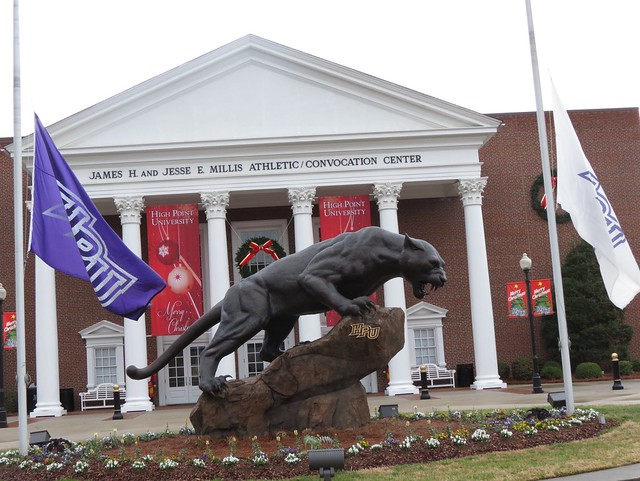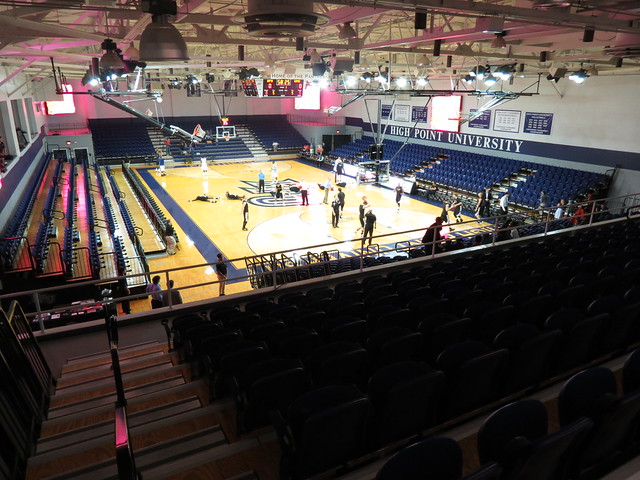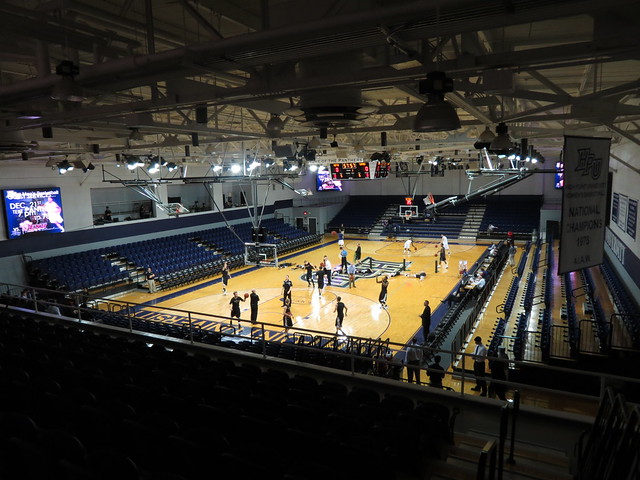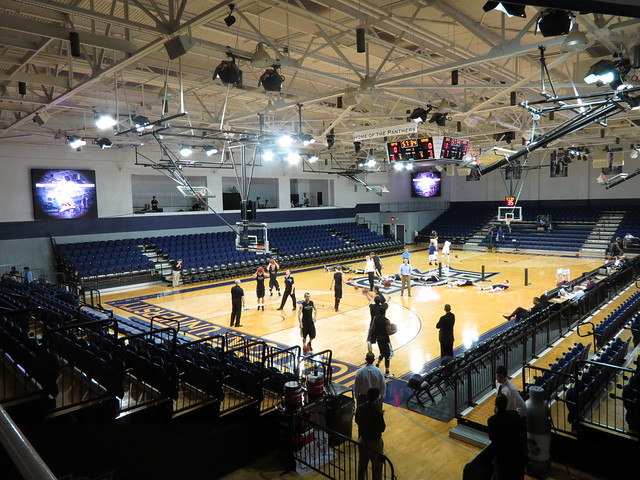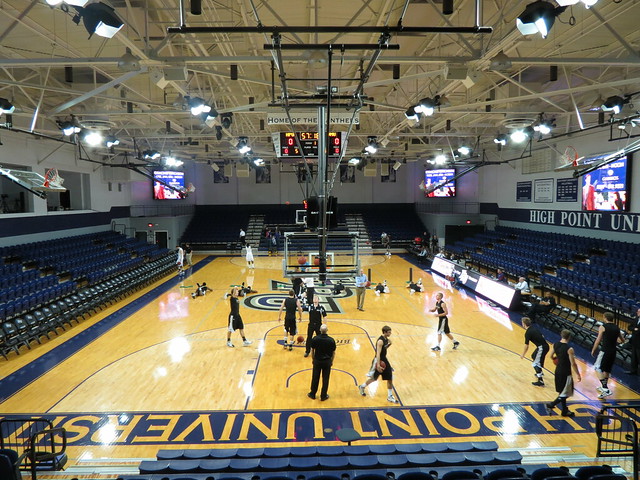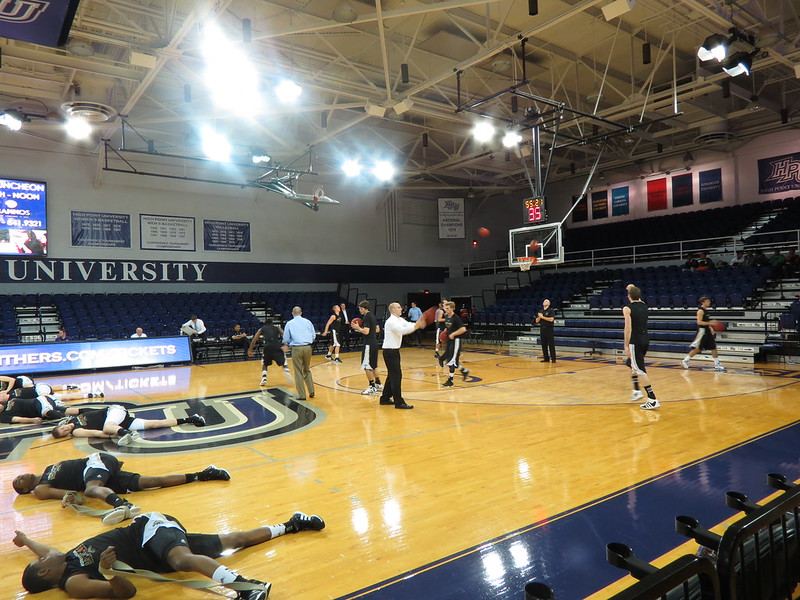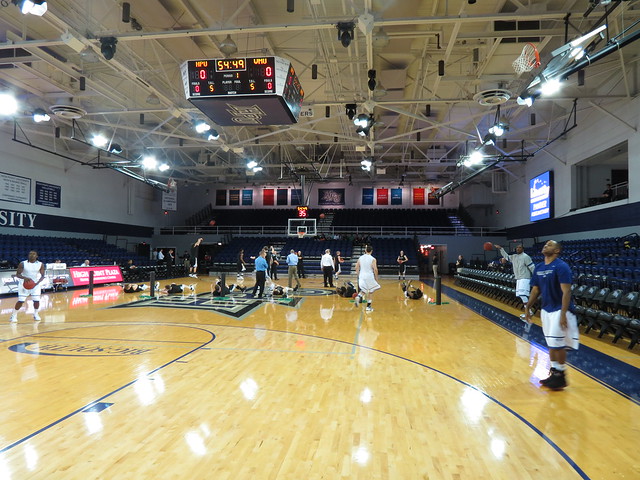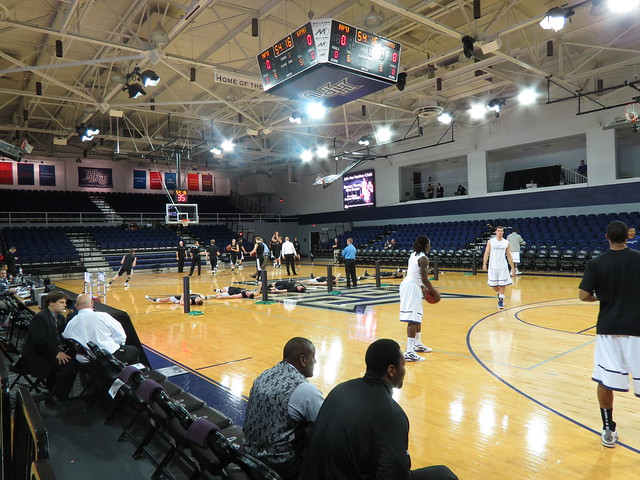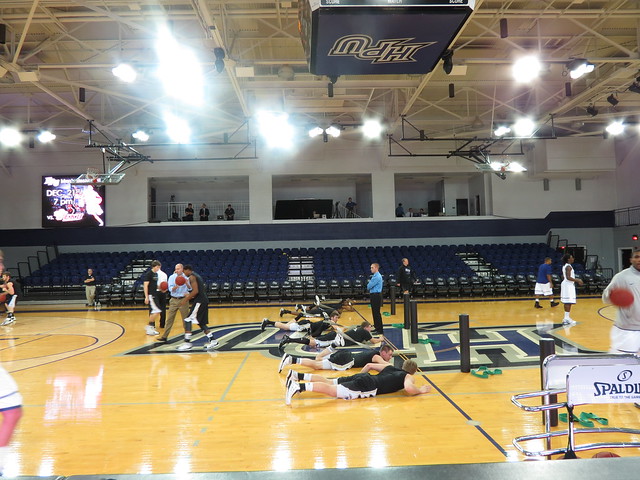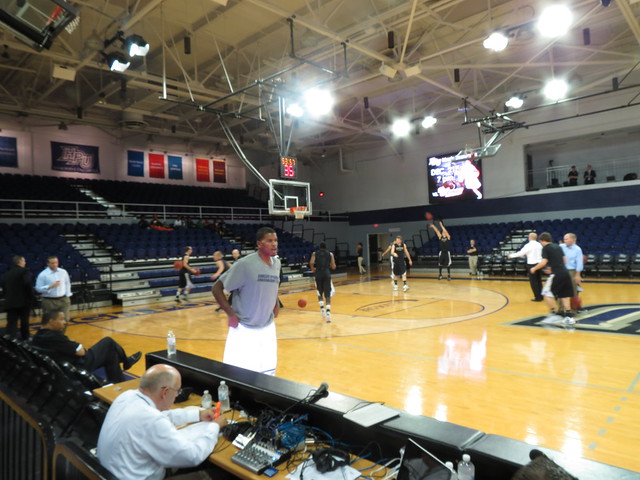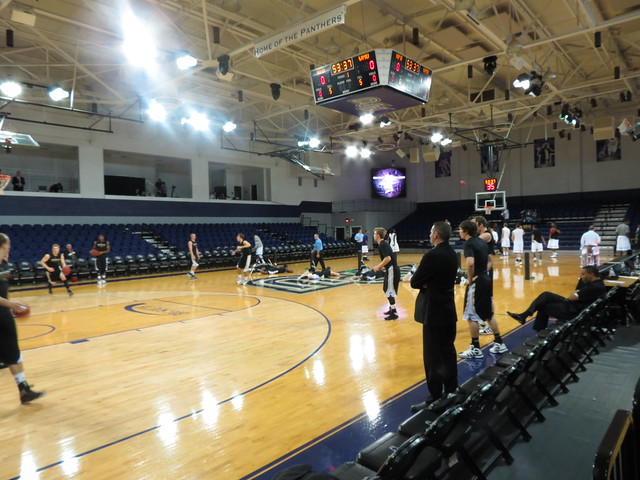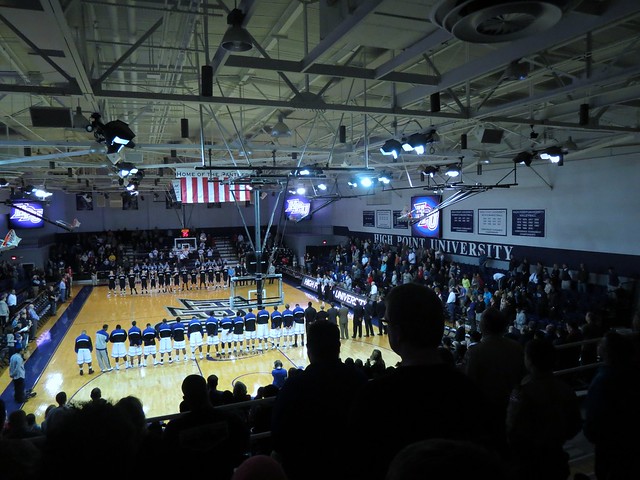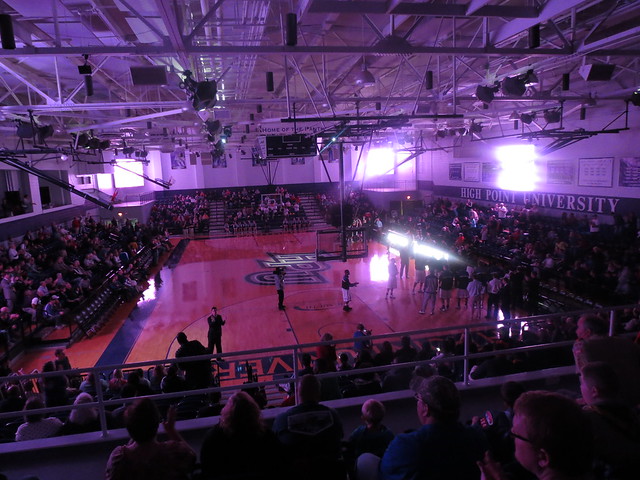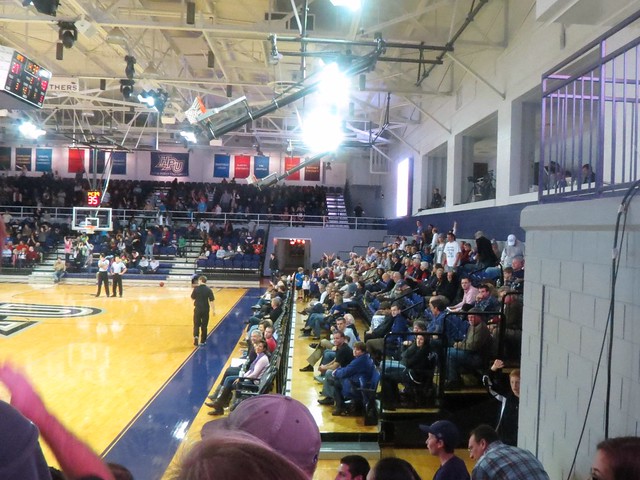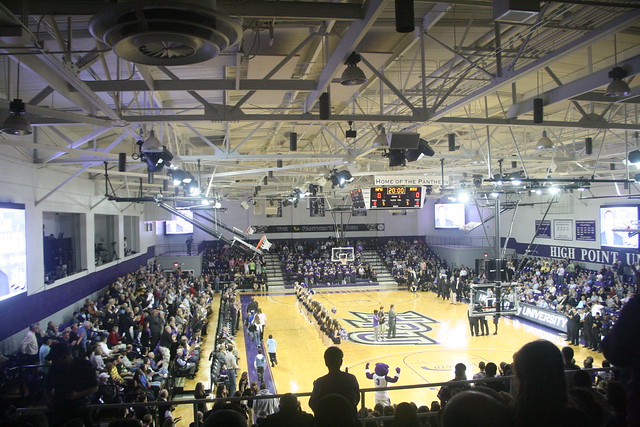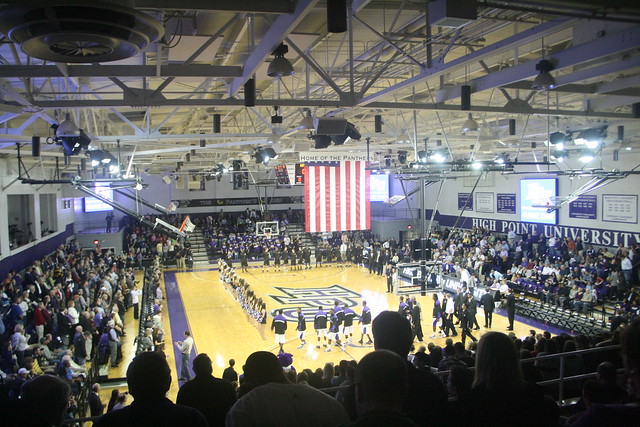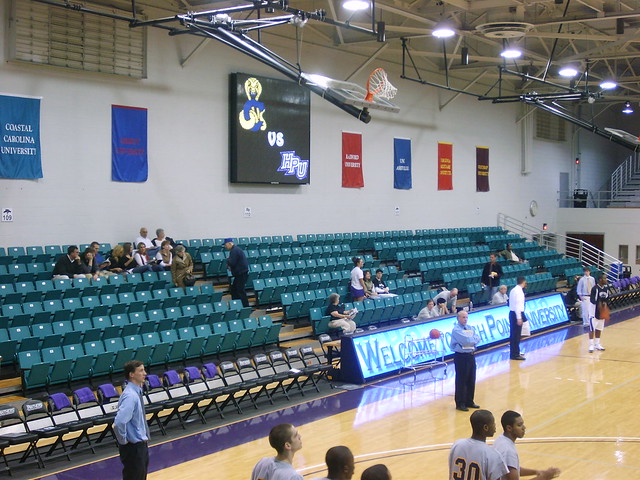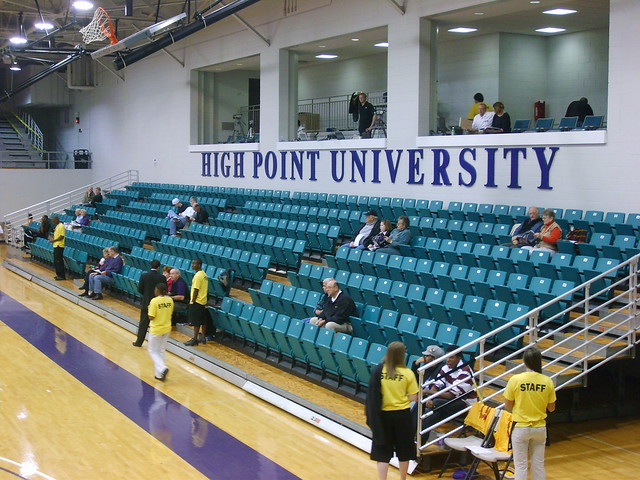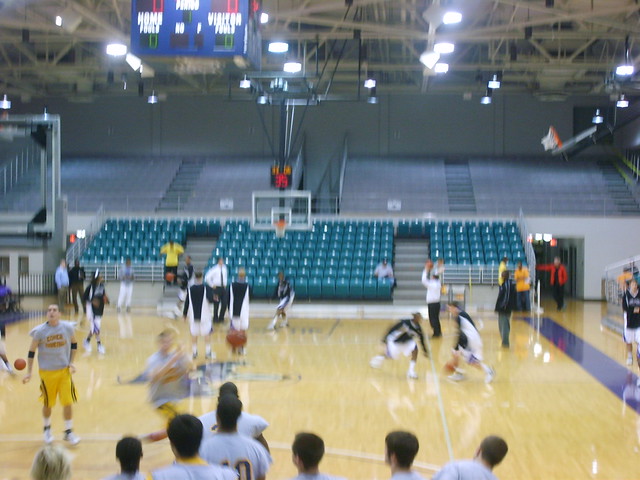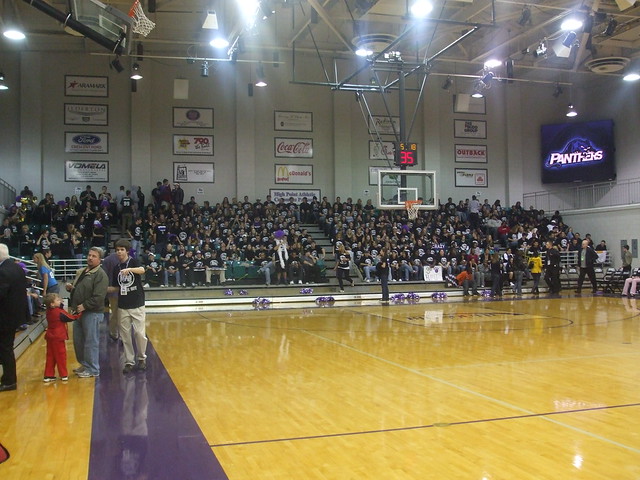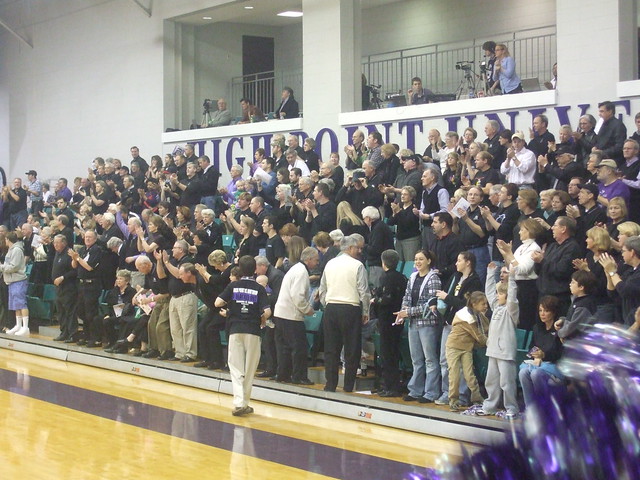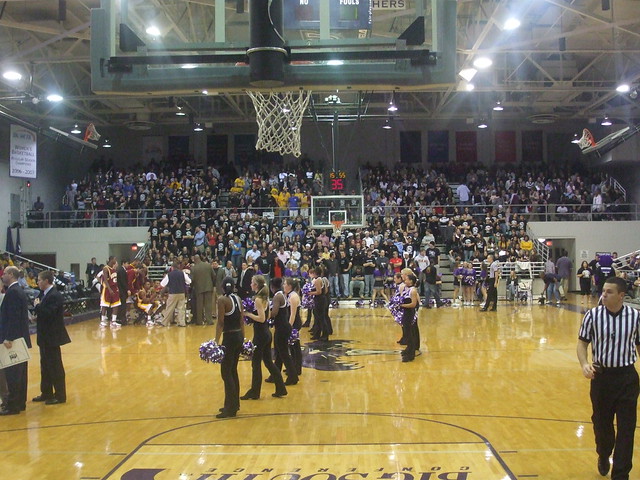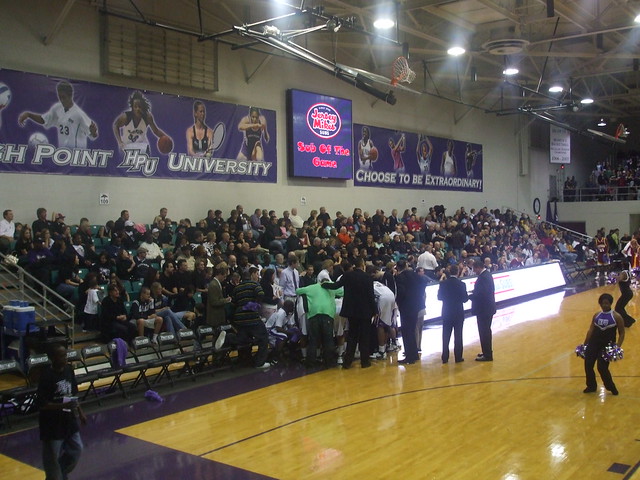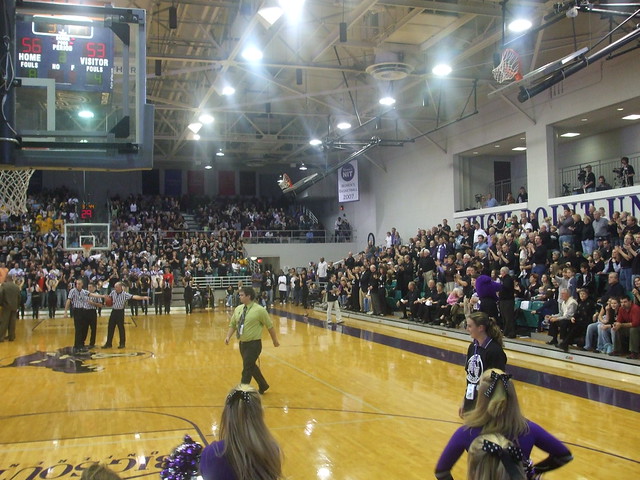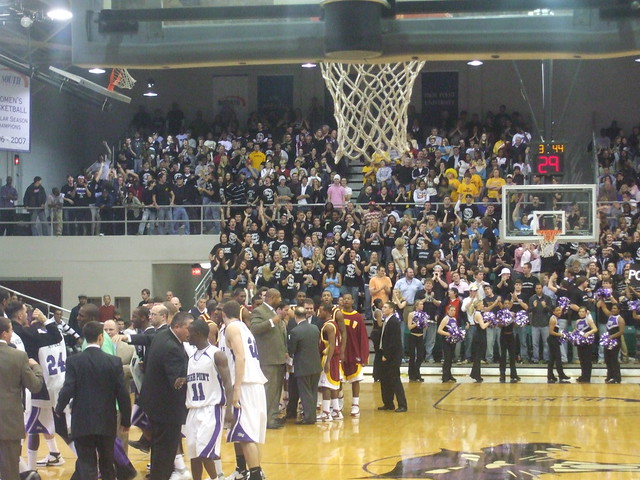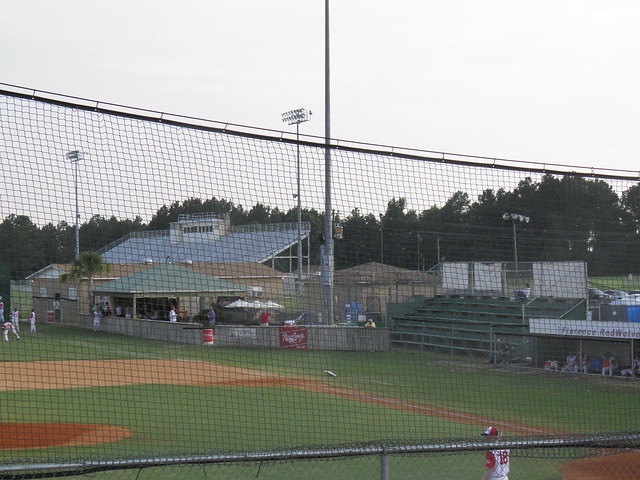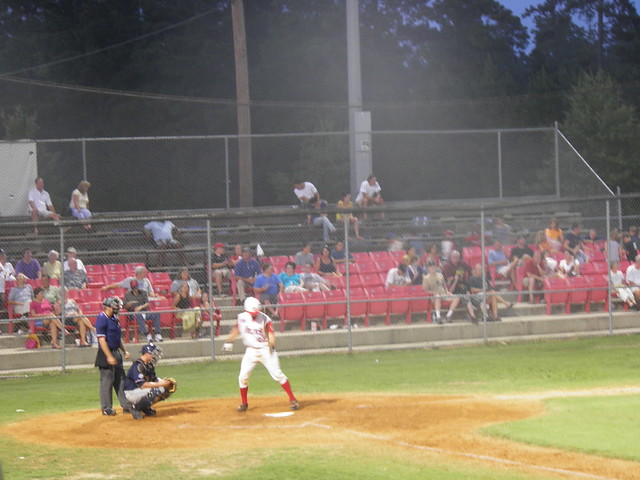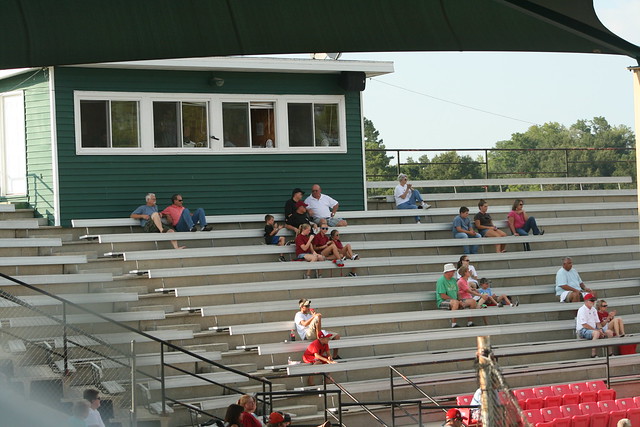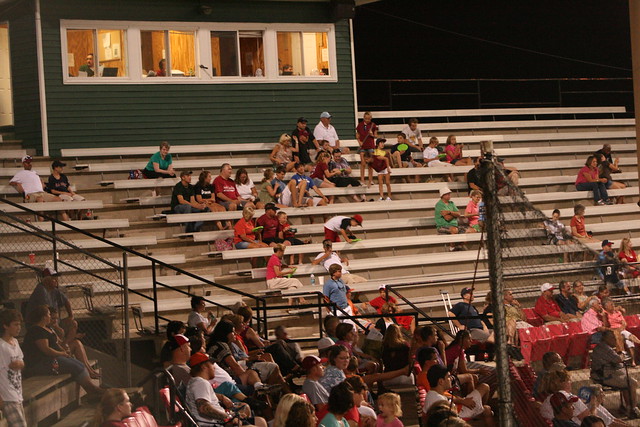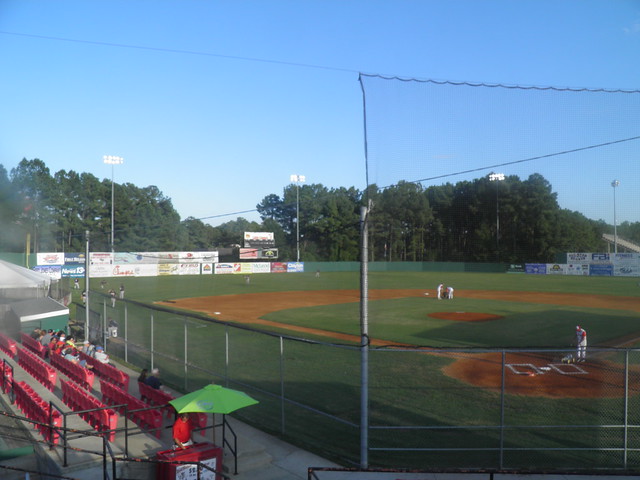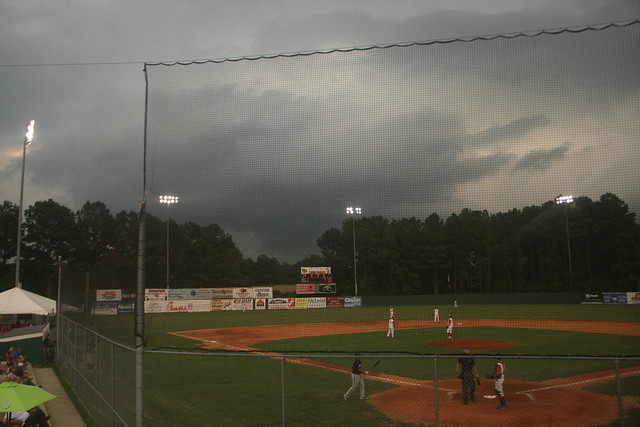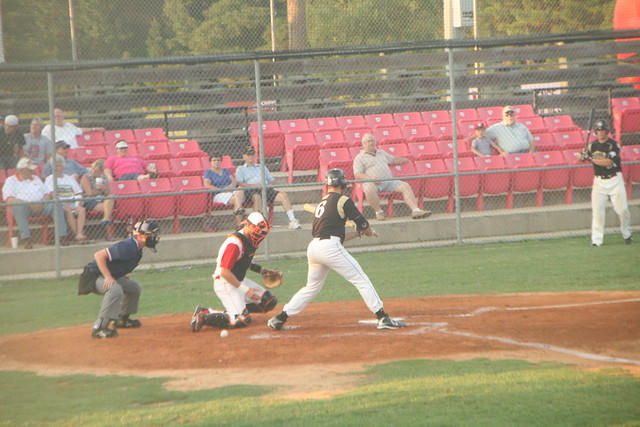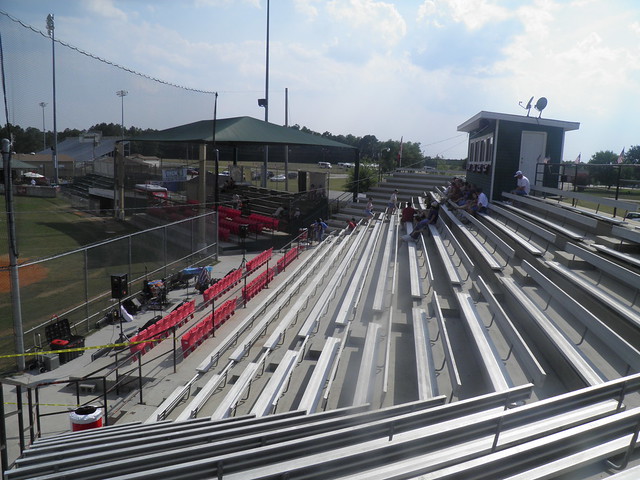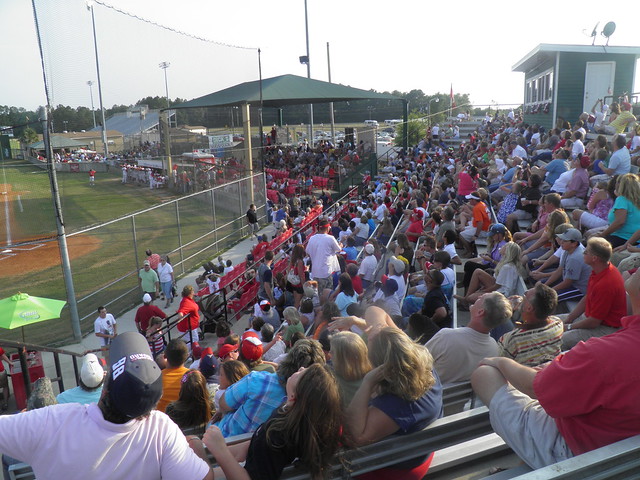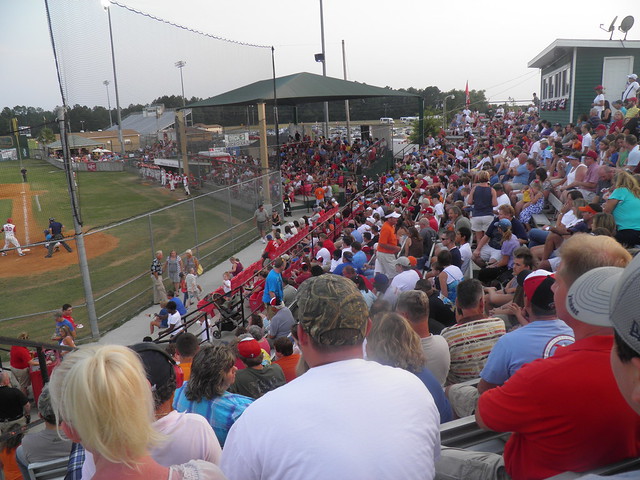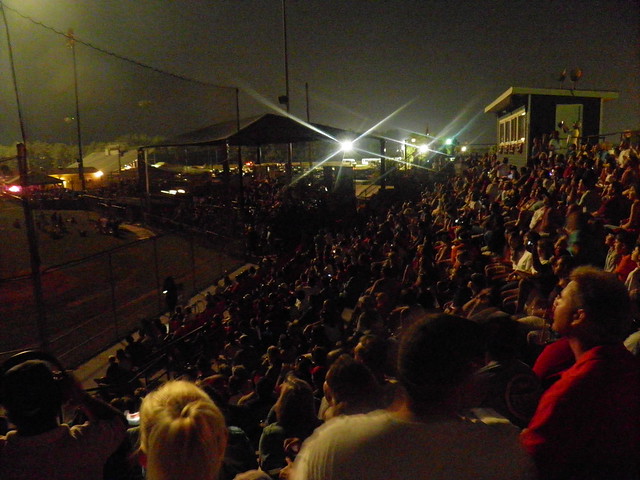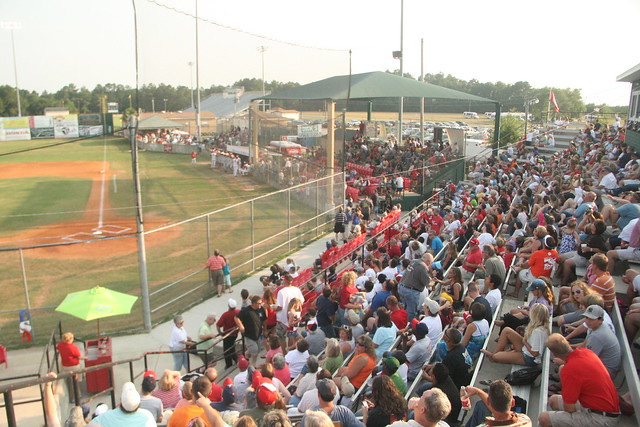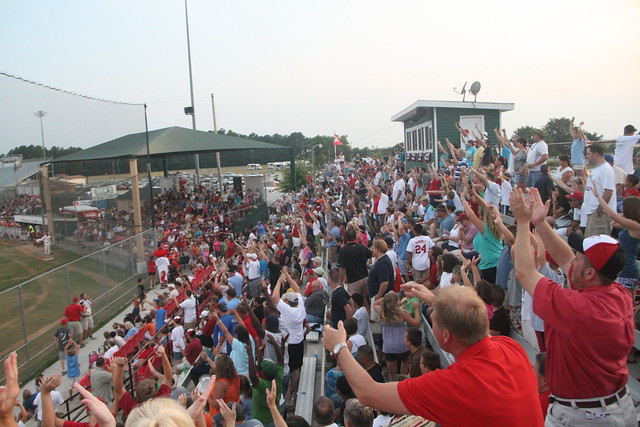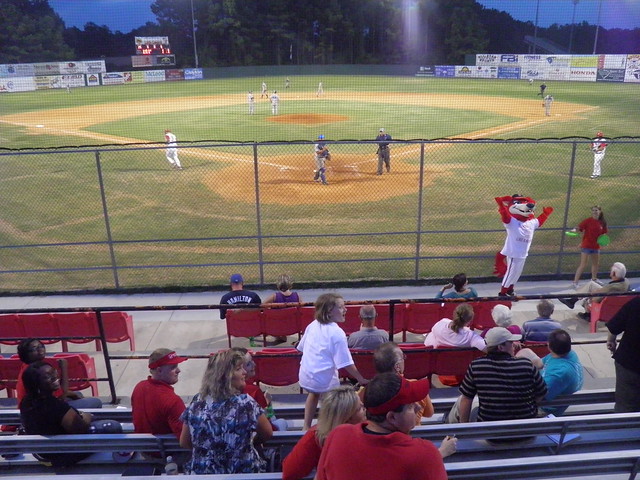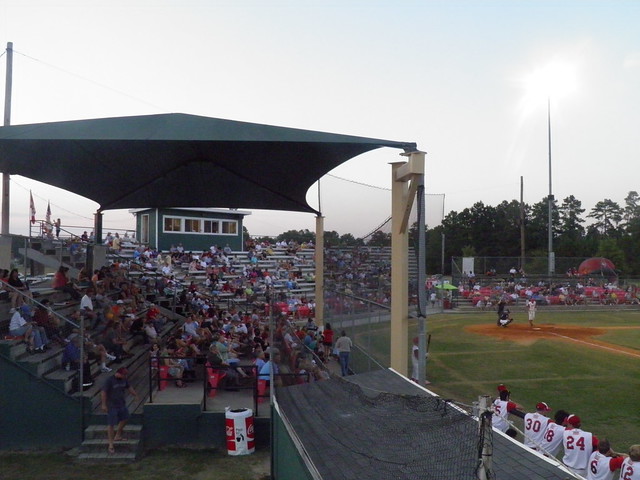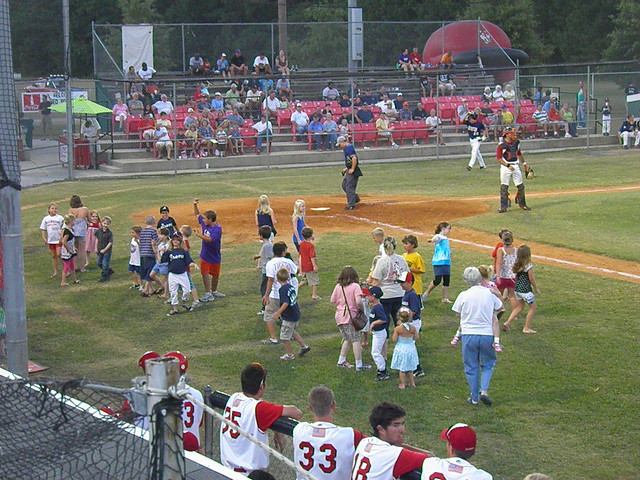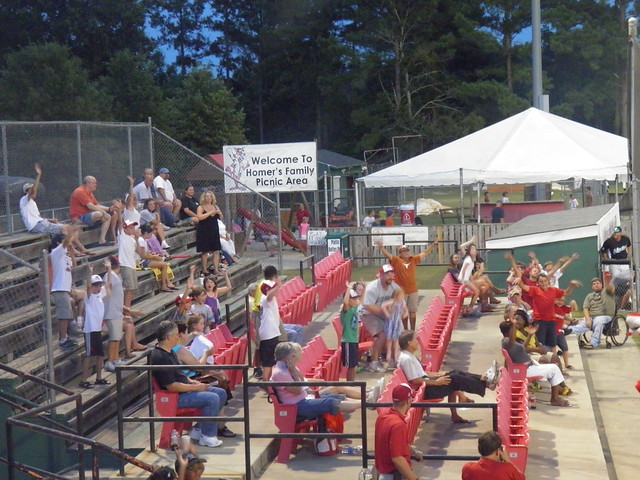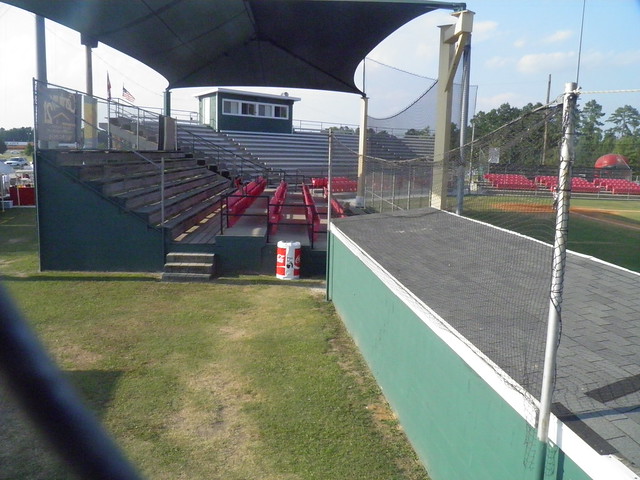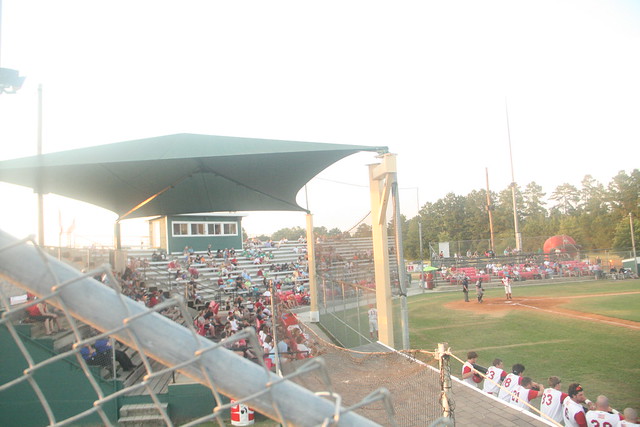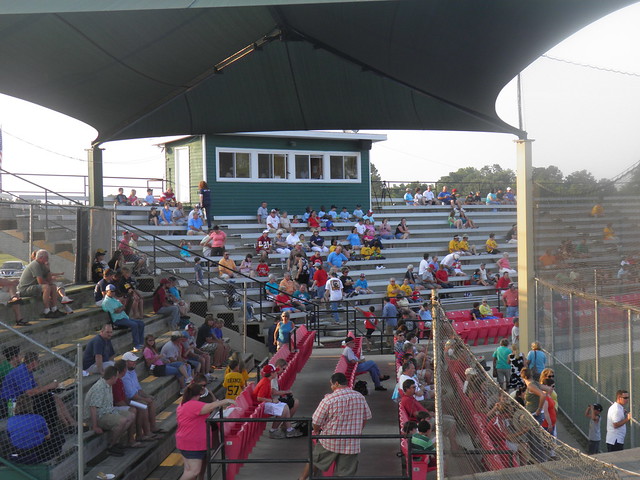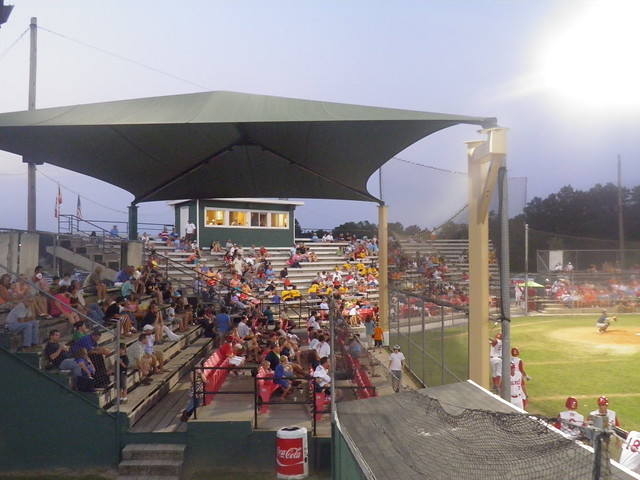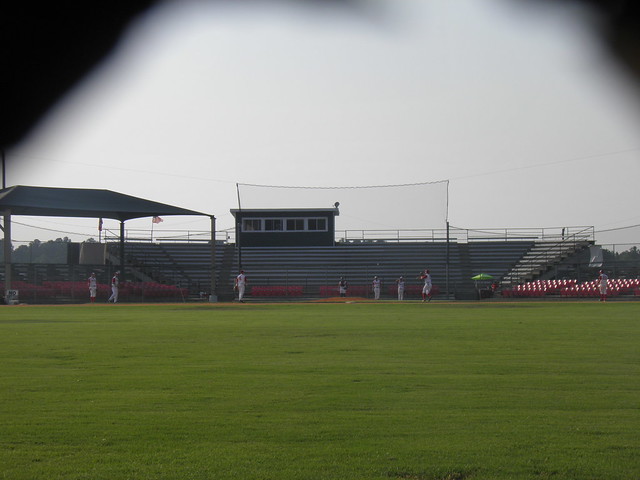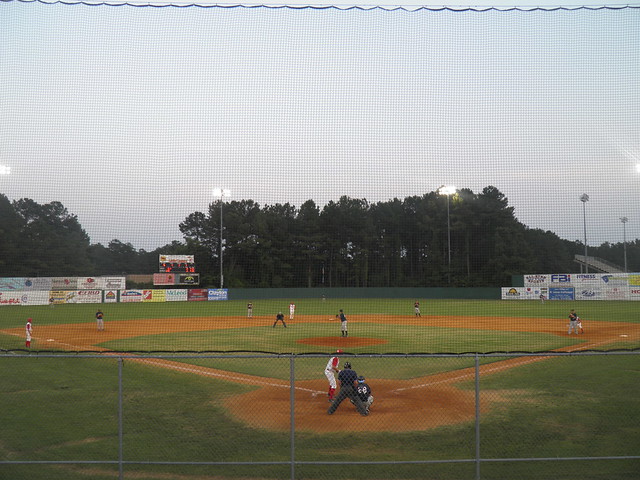Millis Center
Home of High Point Panthers basketball and volleyball
Opened: 1992
Seating Capacity: 1,750
Location: West College Drive (now better known as Panther Drive) between Farris Avenue and North Avenue in High Point, Guilford County, North Carolina
Games seen in Database Era: 56 between August 24, 2007 and March 2, 2013
Latitude: 35.97352 N
Longitude: 79.99565 W
Distance from my house point-to-point (as the crow flies): 142.51 miles
Driving time from my house: 3 hours and 24 minutes (204 minutes)
The Millis Center, as seen prior to the renovations in the summer of 2008:
The Millis Center as shown above is over three hours of driving away from me, and over 140 miles point-to-point. But for four years, this was my home stadium. Prior to the launch of my record keeping in the Database in the late spring of 2007, I went to the Millis Center quite frequently. My first game here was a HPU win over UNC Asheville in February 2004 when I made only my second visit to campus. But during the tenure of AZ Reid at High Point which overlapped mine as a student, I attended over 80 percent of all home men's games, over 60 percent of all home women's games, and over 40 percent of all home volleyball matches. In the six years of the Database, I have been to 56 games. But in three years prior to the Database, I likely went to more than that. The Millis Center is only a ten minute walk from Finch Hall, my home for four years. Since I made my first visit to the HPU campus in the summer of 2003, much has changed. But the Millis Center to a large extent has not.
The Millis Center was completed in 1992. It was basically a heavily renovated and expanded version of its predecessor Alumni Hall, which had sat on the spot since 1957. I have seen pictures of Alumni Hall in old HPU yearbooks, and one can tell that the foundation for the present day Millis Center was still there. Alumni Hall, like the Millis Center, had an unusually high percentage of its seats behind one basket (although the Millis Center has seats behind both baskets). The Millis Center was a much nicer Alumni Hall, more clean-cut and modern with extra amenities for the school including classrooms, athletic offices, weight rooms, and a swimming pool one can view from the concourse. But while the Millis Center (built during the transition of what is now Conference Carolinas from NAIA to Division II) is a much nicer building than Alumni Hall, it actually is not any bigger. And it is certainly not up to Division I standards, which High Point would join in 1999 seven years after the building opened. The arena seats just 1,750, with at least 60 percent of those seats behind the baskets. The big problem for expanding the gym itself past what Alumni Hall had is geography. The Millis Center sits on a hill between two creek beds, which leads to a narrow and oddly laid out gym.
Since becoming High Point University President in 2005, Nido Qubein has done a lot to build the campus up. But much of the increased spending has come on superficial stuff designed to attract more students (particularly those with money). Most of the substantive spending has gone towards accommodating the new students pulled in by Qubein, with HPU having far more residence halls than it did when I was a student with far greater modern amenities than the Finch Hall I was used to. Athletics has not been neglected however. When I was a student in 2007, HPU built new stadiums in soccer and baseball that were of a highly acceptable quality for mid-major athletics. But construction space and money has delayed what Qubein would hope could be a "mini-NBA" arena. The Millis Center was renovated as I was graduating in the summer of 2008, and it was marketed as being almost a different place. But aside from a new paint job and new seats, it was the same Millis Center. And as other schools in the Big South improve arenas like Campbell, Coastal Carolina, and UNC Asheville, the Millis Center could hurt the growth of the basketball program. There are some positives that I will talk about here, but it is not quite what a Division I arena should be.
Seating Capacity: D
Seating only 1,750 fans should normally be a F grade for a Division I arena. But most of the Big South struggles to get over 1500 fans a game, and the same is true for High Point. But with the expansion of the rest of the school along with more students, HPU is on the verge of being pushed to the brink of having an arena that is way too small for its level. When HPU invites touring prospective students as well as visiting families, tickets are unavailable for the general public. And when you are a basketball team at the level of High Point, you should not normally have two Saturdays every year that are impossible to get tickets for. In the near future, it is possible that if the team becomes popular enough (or the enrollment continues to grow) that there will not be enough seats for students (starting in 2007-08 both lower ends of the lower baseline seating goes to students).
The listed capacity prior to the 2008 renovations was 2,565. That number was way overstated, and was dropped to 1,750. Total seating capacity only dropped by about 100 seats during the renovations, not 800. HPU also had a habit of listing attendances much higher than they actually were prior to 2006. For example, in the 2004 game I was at the listed attendance was 1,718 even with few people in the mezzanine (what we call the balcony baseline seating). Actual attendance for that game was probably only slightly more than a thousand. Until the growth of the school under Qubein and before HPU had quality players like AZ Reid and Nick Barbour, empty seats were common. Now 82 percent of all seats are sold on average at the Millis Center for men's games.
Quality of Seats: B-
The seats themselves are great. They are very comfortable, especially the purple padded seats implemented after the renovations. The green plastic seats that preceded them as well as the bleachers in the mezzanine were not particularly comfortable, but the new ones are. But the sightlines are not particularly good at the Millis Center. Unless you are a Panther Club member, your seat will likely be behind the baseline. The student seats are not too bad, as being underneath the basket with the basket support attached to the ceiling is a pretty good view from down low. But if you are in the mezzanine, you will not have the same advantage. It is basically the cheap seats, except in an arena that is already small. But overall you can watch the game and are at least closer to the court at one end than you are in most large venues. But it's not ideal, especially if you are seated low in your section where you have to look over guard rails (also true in some of the sideline seats as well).
Attractiveness/Uniqueness: A
The 2008 renovations made the Millis Center a somewhat attractive and modern place, even though the exterior of the gym is a bit too dark from what it had been. But the great thing about the oddly laid out small gym is that it looks much different from any other arena. Even if you picture a tiny arena, you probably are thinking more like a high school gym. And the Millis Center happens to be a building with the capacity of a high school gym that looks nothing like a high school gym. So if you want to see a unique building, this is the place to go to.
Concessions: C+
Selection is decent, although it varies a bit depending on what food can be imported from the rest of campus. As a result, food selection is down when campus dining is shut down for the holidays. You can usually get the basics as well as pizza and chicken sandwiches, although then again it varies. And while prices have gone slightly up since I graduated, the selection has not. Otherwise the Millis Center would have gotten a higher grade in this category.
Parking: C
When I was a student, I did not normally have to worry about this as much. But parking was a problem at times, with few spaces near the Millis Center. Most of these spaces were either reserved or taken by students and faculty already parked. That is now even more enforced today than it was before. Today general parking is at the soccer stadium over a quarter mile away. You can take a shuttle, which like at Carolina Stadium is not ideal. At least it is better than in the past, where the shuttle left from overflow parking at Oak Hollow Mall a mile and a half away. It is typically easier to walk from the soccer stadium, which now has a sidewalk along West College Drive (now referred to by HPU as Panther Drive, although city signage still often shows it as West College). It is not an easy arena to access, but it is at least better than some of the major conference venues. Typically getting in and out is not a problem unless the HPU campus is busy, which it occasionally can be.
Lighting: B+
The lighting is overall pretty good at the Millis Center for a smaller Division I venue. The lighting is more concentrated on the court than it was prior to the 2008 renovations, when the entire arena was well lit. Now there are some dark spots around the arena, with the gray walls feeling drabbier than the white walls before. The darker portions of the seating areas behind the baskets can sometimes be a challenge for lighting contrast when taking pictures, although it makes it easier to focus on the game itself. Otherwise, the Millis Center does well in this regard compared to most comparable venues.
Fans: A-
I know this is somewhat a homer grade on my part, but the Millis Center is capable of getting loud for big games. A "black out" game against Winthrop is a must-see for any mid-major basketball fan. When the team is playing well and the students are in full-force, the Millis Center can be a great place for basketball. Even the season ticket holders can get passionate about the games, although they are largely an older crowd that seems tightly knit with each other and less so with outsiders and younger fans. As the school continues to encourage more on-campus student activity, the quality of the basketball crowds continues to increase. The crowds were much lighter when I first went, and overall much better now. The one time not to go is when school is not in session. HPU tends to give those student seats away to community groups, meaning the stands are full but of a much lower quality of support. Otherwise, you will see a great basketball atmosphere even if you are only looking down on it from the mezzanine.
Other Stuff: B-
As mentioned early, superficial stuff is something that High Point spends a lot on. So the Millis Center, as small as it may be, will always be kept in great shape. The staff will always treat you well, and you will always feel welcome at the Millis Center. And it will be as modern as a 1,750 seat arena can be, as HPU tries to overcome its lack of size with a higher production value (also very true at USC Upstate's Hodge Center). The jumbotron above the scorers' table sideline was installed for the 2006-07 season, with two more installed before the 2007-08 season. And then another was installed during the renovations prior to the 2008-09 season, bringing the total to four video boards. Most arenas do not have four video boards, much less in a building the size of the Millis Center (Elon is now similar after their recent renovations). HPU tries to be modern, but it still can't overshadow the other shortcomings of the Millis Center. The entire building (not just the seating area) is a bit cramped, and the concourse is also not very good. The Millis Center may not be a nice facility, it just tries to look like one.
Summary: As shown above, the Millis Center comes out decent in most categories. The food sometimes is not too bad, the fans are sometimes great, and the arena is designed to be comfortable and a modern facility. The only problem is that ultimately it is not. If the Millis Center seated 1,750 with a different seating configuration, it would be an adequate facility (for the Big South anyway). If the Millis Center seated much more than 1,750 with its current amenities, it would be a great facility. But what makes a decent Division II arena does not make a great Division I arena. It scores well in most categories, and that is why the overall GPA shown below is actually pretty good. But it still needs to better. It needs to be adequate enough to recruit better basketball players, and at the same time be big enough that out-of-town fans like myself do not have to worry about getting a ticket for select weekends. The Big South is finally starting to catch up in this regard, and as a High Point alum I hope my old school can keep pace.
Overall GPA: 2.7125
